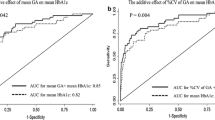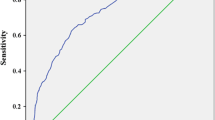Abstract
Aims
We investigated associations between serum levels of glycated albumin (GA) and glycated hemoglobin (HbA1c) and the presence of diabetic peripheral neuropathy (DPN) in patients with type 1 diabetes mellitus (T1DM).
Methods
Between September 2009 and April 2015, we evaluated 314 patients with T1DM in the Endocrinology Department of Shengjing Hospital of China Medical University. We divided the patients into the DPN group (n = 72) and the non-DPN group (n = 242), on the basis of the presence of DPN.
Results
The DPN group had significantly higher GA values than the non-DPN group. After univariate logistic regression, we selected several factors for further analysis: HbA1c, GA, duration of T1DM, body mass index, smoking, hypertension, and the presence of diabetic complications, including nephropathy, retinopathy, and cardiovascular disease. We performed a multivariate logistic regression analysis to examine the association between the presence of DPN and each of these variables. We identified GA, HbA1c, hypertension, smoking, retinopathy, and cardiovascular disease as independent variables for indicating the presence of DPN. Results of a receiver operating characteristic curve analysis revealed that the area under the curve of GA (0.771) was larger than that of HbA1c (0.629). We defined the cutoff value of GA as 23.5 % (sensitivity 0.764, specificity 0.661) and the cutoff value of HbA1c as 8.45 % (sensitivity 0.667, specificity 0.595) for predicting DPN in patients with T1DM.
Conclusions
GA may be a better indicative marker of DPN in patients with T1DM than HbA1c.



Similar content being viewed by others
References
International Diabetes Federation (2014) IDF diabetes atlas [Internet]. 6th edn. http://www.idf.org/diabetesatlas
Witzel II, Jelinek HF, Khalaf K, Lee S, Khandoker AH, Alsafar H (2015) Identifying common genetic risk factors of diabetic neuropathies. Front Endocrinol (Lausanne) 6:88. doi:10.3389/fendo.2015.00088
Botelhoa MC, Conde MG, Rebelo Braz NM (2015) Functional aspects in ageing adults with diabetic neuropathy. A review. Curr Diabetes Rev 12(2):114–119. doi:10.2174/1573399811666150722125612
Kim YA, Kim ES, Hwang HK et al (2014) prevalence and risk factors for the peripheral neuropathy in patients with peripheral arterial occlusive disease. Vasc Spec Int 30(4):125–132. doi:10.5758/vsi.2014.30.4.125
Spallone V, Ziegler D, Freeman R et al (2011) Cardiovascular autonomic neuropathy in diabetes: clinical impact, assessment, diagnosis, and management. Diabetes Metab Res Rev 27(7):639–653. doi:10.1002/dmrr.1239
Wilson NM, Wright DE (2012) Inflammatory mediators in diabetic neuropathy. J Diabetes Metab s5(4):1–6. doi:10.4172/2155-6156.S5-004
Huh JH, Kim KJ, Lee BW et al (2014) The relationship between BMI and glycated albumin to glycated hemoglobin (GA/A1c) ratio according to glucose tolerance status. PLoS One 9(2):e89478. doi:10.1371/journal.pone.0089478
Hwang YC, Jung CH, Ahn HY et al (2014) Optimal glycated albumin cutoff value to diagnose diabetes in Korean adults: a retrospective study based on the oral glucose tolerance test. Clin Chim Acta 437:1–5. doi:10.1016/j.cca.2014.06.027
Kim KJ, Lee BW (2012) The roles of glycated albumin as intermediate glycation index and pathogenic protein. Diabetes Metab J 36(2):98–107. doi:10.4093/dmj.2012.36.2.98
Song SO, Kim KJ, Lee BW, Kang ES, Cha BS, Lee HC (2012) Serum glycated albumin predicts the progression of carotid arterial atherosclerosis. Atherosclerosis 225(2):450–455. doi:10.1016/j.atherosclerosis.2012.09.005
Xu F, Zhao LH, Su JB et al (2014) The relationship between glycemic variability and diabetic peripheral neuropathy in type 2 diabetes with well-controlled HbA1c. Diabeto Metab Syndr 6(1):139. doi:10.1186/1758-5996-6-139
Levin A, Rocco M (2007) KDOQI Clinical practice guidelines and clinical practice recommendations for diabetes and chronic kidney disease. Am J Kidney Dis 49(2):S10–S179
Tesfaye S, Boulton AJ, Dyck PJ et al (2010) Diabetic neuropathies: update on definitions, diagnostic criteria, estimation of severity, and treatments. Diabetes Care 33(10):2285–2293. doi:10.2337/dc10-1303
Tesfaye S, Chaturvedi N, Eaton SE et al (2005) Vascular risk factors and diabetic neuropathy. N Engl J Med 352(4):341–350. doi:10.1056/NEJMoa032782
Diabetes branch of Chinese Medical Association (2014) Guideline for T2DM in China, 2013 Edition. Chin J Endocrinol Metab 30(10):893–942
Tahara Y, Shima K (1995) Kinetics of HbA1c, glycated albumin, and fructosamine and analysis of their weight functions against preceding plasma glucose level. Diabetes Care 18(4):440–447. doi:10.2337/diacare.18.4.440
Takahashi S, Uchino H, Shimizu T et al (2007) Comparison of glycated albumin (GA) and glycated hemoglobin (HbA1c) in type 2 diabetic patients: usefulness of GA for evaluation of short-term changes in glycemic control. Endocr J 54(1):139–144. doi:10.1507/endocrj.K06-103
Ai M, Otokozawa S, Schaefer EJ et al (2009) Glycated albumin and direct low density lipoprotein cholesterol levels in type 2 diabetes mellitus. Clin Chim Acta 406(1–2):71–74. doi:10.1016/j.cca.2009.05.015
Koga M, Hashimoto K, Murai J et al (2011) Usefulness of glycated albumin as an indicator of glycemic control status in patients with hemolytic anemia. Clin Chim Acta 412(3–4):253–257. doi:10.1016/j.cca.2010.10.014
Yoshiuchi K, Matsuhisa M, Katakami N et al (2008) Glycated albumin is a better indicator for glucose excursion than glycated hemoglobin in type 1 and type 2 diabetes. Endocr J 55(3):503–507. doi:10.1507/endocrj.K07E-089
American Diabetes Association (2016) Standards of medical care in diabetes-2016. Diabetes Care 39(s1):s39–s46
Suwa T, Ohta A, Matsui T et al (2010) Relationship between clinical markers of glycemia and glucose excursion evaluated by continuous glucose monitoring (CGM). Endocr J 57(2):135–140. doi:10.1507/endocrj.K09E-234
Selvin E, Francis LM, Ballantyne CM et al (2011) Nontraditional markers of glycemia: associations with microvascular conditions. Diabetes Care 34(4):960–967. doi:10.2337/dc10-1945
Tesfaye S, Stevens LK, Stephenson JM et al (1996) Prevalence of diabetic peripheral neuropathy and its relation to glycaemic control and potential risk factors: the EURODIAB IDDM Complications Study. Diabetologia 39(11):1377–1384. doi:10.1007/s001250050586
Maser RE, Steenkiste AR, Dorman JS et al (1989) Epidemiological correlates of diabetic neuropathy. Report from pittsburgh epidemiology of diabetes complications study. Diabetes 38(11):1456–1461. doi:10.2337/diabetes.38.11.1456
Franklin GM, Kahn LB, Baxter J, Marshall JA, Hamman RF (1990) Sensory neuropathy in non-insulin-dependent diabetes mellitus. The San Luis Valley diabetes study. Am J Epidemiol 131(4):633–643
Dyrberg T, Benn J, Christiansen JS, Hilsted J, Nerup J (1981) Prevalence of diabetic autonomic neuropathy measured by simple bedside tests. Diabetologia 20(3):190–194
Hreidarsson AB (1982) Pupil size in insulin-dependent diabetes: relationship to duration, metabolic control, and long-term manifestations. Diabetes 31(5):442–448. doi:10.2337/diabetes.31.5.442
Acknowledgments
This work was supported by the National Natural Science Foundation of China (Nos. 81301627 and 81500628); Liaoning Province Doctor Startup Foundation (No. 20131146).
Author information
Authors and Affiliations
Corresponding author
Ethics declarations
Conflict of interests
The authors declare that there is no conflict of interests regarding the publication of this paper.
Human and animal rights
All procedures followed were in accordance with the ethical standards of ethics committee of Shengjing Hospital of China Medical University on human experimentation and with the Helsinki Declaration of 1975, as revised in 2008 (5).
Informed consent
Informed consent was obtained from all patients for being included in the study.
Additional information
Managed by Massimo Federici.
Rights and permissions
About this article
Cite this article
Wang, N., Guo, C., Han, P. et al. Glycated albumin indicates peripheral diabetic neuropathy. Acta Diabetol 53, 973–979 (2016). https://doi.org/10.1007/s00592-016-0900-y
Received:
Accepted:
Published:
Issue Date:
DOI: https://doi.org/10.1007/s00592-016-0900-y




